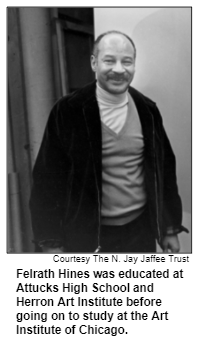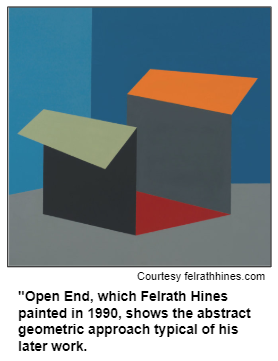Apr 19, 2019
(April 13, 2019) It may seem remarkable that his abstract artwork often reflected harmony and balance, given the struggles he faced in establishing himself as a prominent artist.

Today, paintings by Hines (1913-1993) are exhibited at museums across the country, including the National Museum of African American History and Culture in Washington D.C. and the Indianapolis Museum of Art at Newfields. For several years, Hines worked with Georgia O'Keeffe as her private paintings restorer.
We explore the life and impact of Hines - as well as other artists - with two studio guests:
- Rachel Berenson Perry, author a new book, The Life and Art of Felrath Hines: From Dark to Light (IU Press and Indiana Historical Society Press). Rachel, who lives in Brown County, is the former fine arts curator for the Indiana State Museum. She has been a frequent guest on Hoosier History Live shows about other Indiana artists, including T.C. Steele and William Forsyth, the subjects of some of Rachel's other books.
- And Mark Ruschman, senior curator of art and culture at the Indiana State Museum, who put Rachel in touch with Hines' widow several years ago. In June, the State Museum will open an exhibit titled It's About Time: The Artwork of Felrath Hines.

During his career, Hines fought against, as Rachel puts it, "being pigeonholed as a black artist" - even when turning down opportunities for his paintings to be included in exhibits of African American artwork hurt his career.
During our show, guest Mark Ruschman also discusses other notable painters, including two who attended Manual High School in Indianapolis during the early 1900s: William Edouard Scott (1884-1964) and John Wesley Hardrick (1891-1968). At Manual, both Scott and Hardrick studied under famous Hoosier Group painter Otto Stark.
Like Hines, Hardrick went on to attend Herron. Unlike Hines, whose career flourished after he focused on abstract art, Hardrick painted landscapes, still lifes and portraits. The Indiana State Museum and the Indianapolis Museum of Art own paintings by Hardrick, who lived in Indianapolis all of his life.
In contrast, Hines was based during the 1960s in New York City, where he befriended well-known jazz musicians like Billy Strayhorn. In 1972, Hines moved to the Washington D.C. area to become the conservator of the National Portrait Gallery.